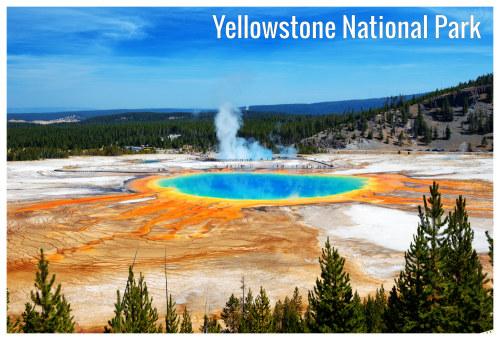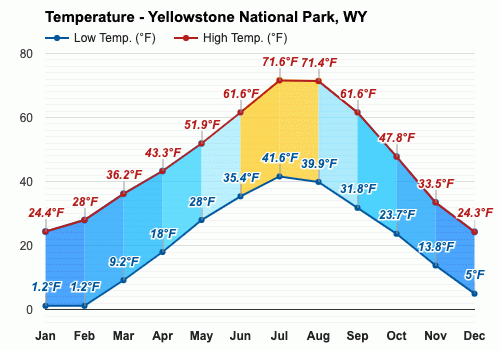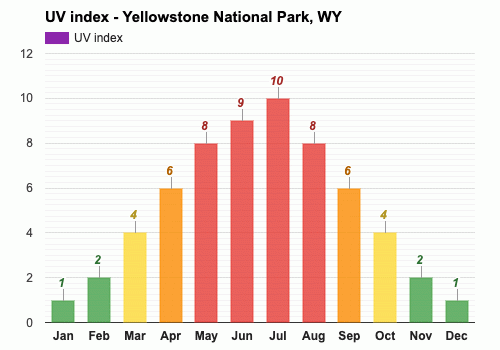
November
Weather in November
Temperature
As October transitions into November, Yellowstone National Park sees a clear drop in the average high-temperature, declining from a frosty 47.8°F (8.8°C) to a wintry 33.4°F (0.8°C). In Yellowstone National Park, the November nights cool down to an average low of 13.8°F (-10.1°C).Rainfall
In Yellowstone National Park, in November, during 13.1 rainfall days, 1.85" (47mm) of precipitation is typically accumulated. In Yellowstone National Park, during the entire year, the rain falls for 151 days and collects up to 20.91" (531mm) of precipitation.Snowfall
Months with snowfall are January through June, September through December. In Yellowstone National Park, during November, snow falls for 12.6 days and regularly aggregates up to 30.91" (785mm) of snow. In Yellowstone National Park, during the entire year, snow falls for 91.4 days and aggregates up to 193.7" (4920mm) of snow.Daylight
In November, the average length of the day is 9h and 37min.On the first day of November, sunrise is at 8:00 am and sunset at 6:11 pm MDT. On the last day of the month, sunrise is at 7:38 am and sunset at 4:44 pm MST.
Note: On Sunday, November 3. 2024, at 2:00 am, Daylight Saving Time ends, and the time zone changes from MDT to MST. Daylight Saving Time starts again on Sunday, March 9. 2025, at 2:00 am; consequently, the time zone reverts from MST to MDT.
Sunshine
In November, the average sunshine is 5h.UV index
The average daily maximum UV index in November is 2. A UV Index of 2, and less, symbolizes a low health risk from unprotected exposure to Sun's UV rays for the average person.Note: The maximum UV index of 2 during November translates into these guidelines:
Long-term sun exposure is typically not a concern for most. However, those with sensitive skin, infants, and children must always have protection. The midday Sun can be harmful due to its potent UV radiation; seek shade and reduce exposure. Sunglasses providing both UVA and UVB protection are non-negotiable on sunlit days. Mark this! Snow reflection can nearly double the UV radiation intensity from the Sun.
Published by: Weather U.S. | About Us
Data Sources | Weather Forecasting & Climate
Frequently asked questions
How cold is November?
How many days does it rain in November?
How much does it snow in November?
What is the average length of the day in November?
When is the sunrise / sunset in November?
When does Daylight Saving Time (DST) end in November?
How long on average sun shines in November?
What is the UV index intensity in November?

Average temperature in November
Yellowstone National Park, WY
- Average high temperature in November: 33.5°F
The warmest month (with the highest average high temperature) is July (71.6°F).
The month with the lowest average high temperature is December (24.3°F).
- Average low temperature in November: 13.8°F
The month with the highest average low temperature is July (41.6°F).
The coldest months (with the lowest average low temperature) are January and February (1.2°F).

Average rainfall in November
Yellowstone National Park, WY
- Average rainfall in November: 1.9"
The wettest month (with the highest rainfall) is May (2.5").
The driest month (with the least rainfall) is October (1.2").

Average rainfall days in November
Yellowstone National Park, WY
- Average rainfall days in November: 13.1 days
The month with the highest number of rainy days is January (16.8 days).
The month with the least rainy days is October (8.8 days).

Average snowfall in November
Yellowstone National Park, WY
- Average snowfall in November: 30.9"
The month with the highest snowfall is January (34.3").
The months with the least snowfall are July and August (0").

Average snowfall days in November
Yellowstone National Park, WY
- Average snowfall days in November: 12.6 days
The month with the highest number of snowfall days is January (16.2 days).
The months with the least snowfall days are July and August (0 days).

Average daylight in November /
Average sunshine in November
Yellowstone National Park, WY
- Average daylight in November: 9h and 4min
The month with the longest days is June (Average daylight: 15h and 30min).
The month with the shortest days is December (Average daylight: 8h and 54min).
- Average sunshine in November: 5h
The month with the most sunshine is July (Average sunshine: 11h).
The month with the least sunshine is December (Average sunshine: 4h).

Average UV index in November
Yellowstone National Park, WY
- Average UV index in November: 2
The month with the highest UV index is July (UV index 10).
The months with the lowest UV index are January and December (UV index 1).